Restoring our Egyptian Revival Gateway: The Iron Fence
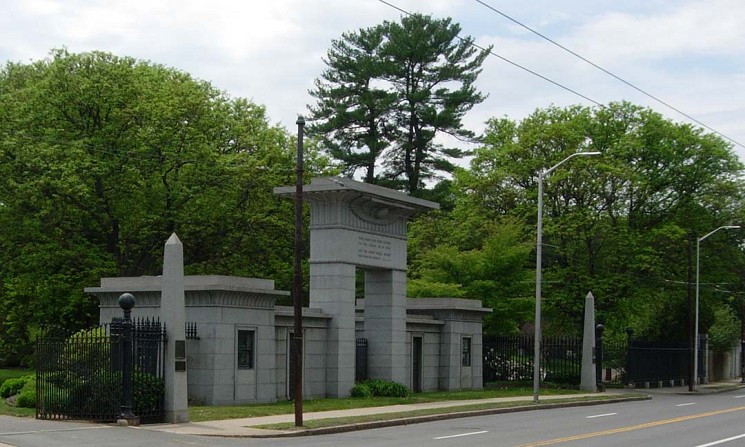
The historic cast iron fence that flanks our Egyptian Revival Gateway are the remaining sections of a fence that once ran the entire length of the Cemetery’s boundary on Mount Auburn Street. Over the years the fence suffered repeated damage from automobile accidents, downed trees, and the inevitable effects of water and rust. In the 1980’s much of the fence was dismantled, and the most intact panels were reused and installed in their current configuration. Now Mount Auburn is working with Cassidy Brothers Forge, out of Rowley,MA, and embarking on a complete restoration of the remaining sections of fence as well as the auto gates to ensure that they will last another 170 years.
Unlike previous repair and painting projects, the fence is being dismantled into its component parts. These parts, from top to bottom, include the finials, top rail, pickets, and bottom rails. To remove the finials, the contractor has fabricated a devise that clamps both the picket and the finial, and then through two hydraulic pistons the finial is pried away from a connecting square wrought iron bar (see photo gallery below, picture 1). The rod/finial connection has proved especially tenacious due to the sulfur mixture that was historically used to join and set fence components. The sulfur mixture was poured into port cast into the finial, and filled any gaps around the connecting rod. Over the years this connection has become extremely tight as the sulfur has reacted with the iron. The use of the clamping devise by the contractors minimizes stress on the cast iron rail, which is brittle and easily cracked (2).
After removing the finials, the top rail is slowly separated and lifted off tops of the pickets (5). Once this is complete, each picket has to be separated from the bottom rail (6). A similar clamping device has been fabricated to pull the pickets out of the socket and round collar into which they were originally set. Many of the original collars have disintegrated, but the pickets often remain securely attached to the bottom rail. Again, when originally constructed the pickets were secured to the rail by pouring a sulfur mixture into the socket, and the reaction of the sulfur to the metal has made this connection very tenacious.
Once all of the pickets have been removed the bottom railing can be lifted out. The bottom rail is actually a single casting, approximately 1 foot tall, that is comprised of two rails connected by decorative floral patterns alternating with chamfered pickets. In its current configuration, the bottom rail sits in a notch cut into the granite post bases (7).
As the panels have been dismantled, they are disconnected from the cast iron posts. Tenons on the ends of the top railings may have originally been set into corresponding mortises on the posts, but that detail changed over the years due to damage and deterioration. The top rail now attaches to a steel bar that extends through the post. The post was secured to the granite post base by a threaded rod that was anchored in the base and ran to the full height of the post. The top finial of the post screws onto the rod and, once tightened, secures the post in position. Most of these threaded rods have rusted through and snap when turning the post finial (8,9).
PHOTO GALLERY: Dismantling the Fence, August 2015
- 1: Device for lifting finials off connecting bars.
- 2: Finials Removed.
- 3: Finials
- 4: Top rail, pickets, and post.
- 5: Using hydraulic jack to gently push top rail off pickets.
- 6: Pickets removed from sockets.
- 7: Bottom rail in notch in granite base.
- 8: Bottom rail in notch and rust scale from inside of post, all that remains of threaded rod connecting the post to the base.
- 9: Top of post showing hole for threaded rod.
Support for this project has been provided by:
Massachusetts Cultural Facilities Fund, a program of the Commonwealth of Massachusetts administered through a collaborative arrangement between Mass Development and the Massachusetts Cultural Council,
a City of Cambridge Historical Commission Community Preservation Act grant,
Cambridge Savings Bank,
and
the Harold Whitworth Pierce Charitable Trust.

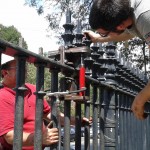
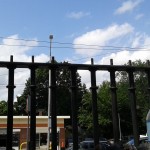
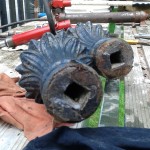
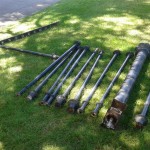
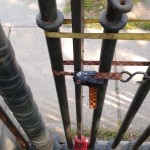
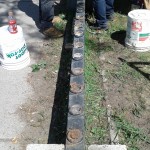
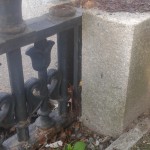
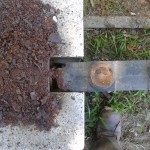
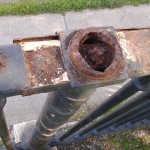
Leave a Reply